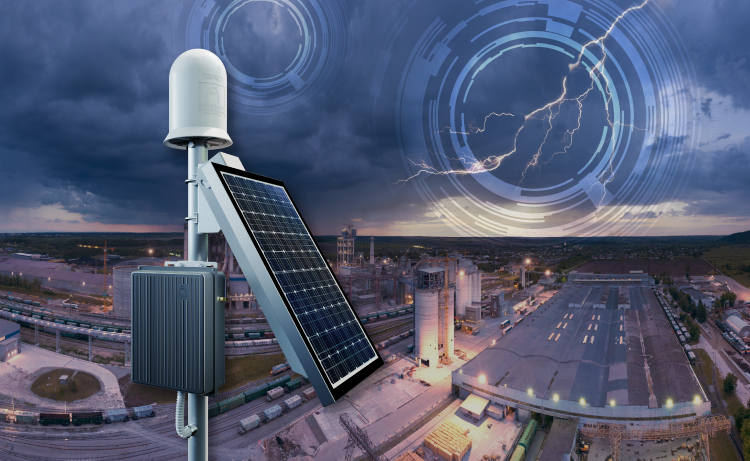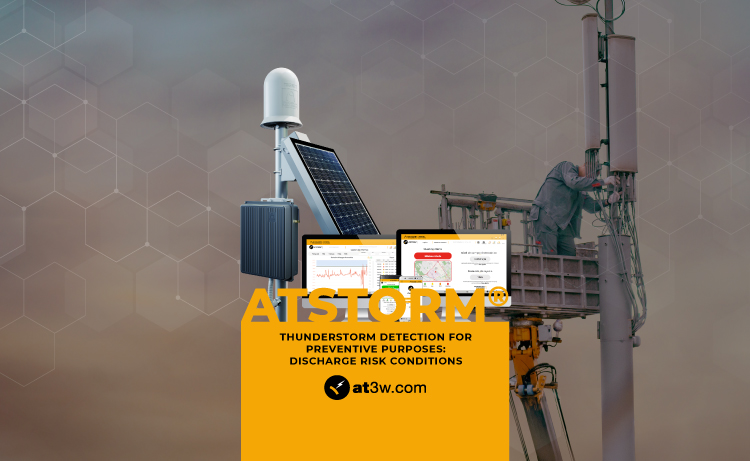Lightning is a natural phenomenon that can occur with a high frequency at any time of the year and is subject to statistical uncertainty: it is not possible to determine where and when an isolated lightning strike will occur. Because of this, storm detection systems cannot precisely predict the location and timing of a particular discharge1, but they can determine the Discharge Risk Conditions based on the distance of previous lightning strikes (electromagnetic field detectors) or the variation of the atmospheric electrostatic field (electrostatic field sensors).
Although the formation of thunderstorms cannot be avoided, early detection makes it possible to minimise the risks resulting from a possible lightning strike and to avoid personal injury, providing information for the correct management of temporary preventive measures. For this purpose, it is necessary that these detectors are capable of assessing the Discharge Risk Conditions. Next, we will detail how the different types of available storm detectors determine the Discharge Risk Conditions.
Types of thunderstorm detectors: electromagnetic field-based vs. electrostatic field-based systems
Existing storm detectors either use electromagnetic radiation from lightning strikes to locate them once they have struck, or measure the ambient electrostatic field which is the direct indicator of the risk of lightning discharge.
Electromagnetic field-based detectors consider the risk of lightning strikes according to the distance of previous lightning strikes from the area to be protected. In fact, they can only detect lightning once it has occurred and assume not only that there will be more lightning strikes, but also that the lightning strikes will be closer to the target.
The factual measurement of the electrostatic field allows the determination of the Discharge Risk Conditions
Unlike electromagnetic field-based detectors, electrostatic field sensors are based on measuring the atmospheric electrostatic field. This field at the earth’s surface can vary for many reasons (e.g. altitude, latitude, temperature, pollution, wind speed, humidity, solar radiation, etc.), but is generally around +100-150 V/m in good weather conditions without clouds. During good weather, there is an equilibrium in the atmosphere between positive and negative charges, where the earth is usually more negatively charged than the air and the elements above the ground2. When storm clouds form, a polarisation of electric charges occurs, so that the lower part of the clouds is negatively charged (in most cases), inducing a positive charge on the earth and the elements above it. The electric field formed in these circumstances can reach tens of kV. Thus, although air is an almost perfect electrical insulator in good weather conditions, when a sufficiently high electric field is generated, it ionises and becomes a conductive medium through which the charge accumulated in the clouds circulates3.
Therefore, when going from good weather conditions to stormy conditions, there is a variation of the atmospheric electric field (from +100-150 V/m to tens of kV/m), which allows to warn of the formation or approach of storms in the area to be protected with enough time in advance to implement the necessary preventive measures. This elevation of the electrostatic field can be produced by the formation of storms in the area, as well as by the passage of storm clouds that do not necessarily imply discharges in the environment4: for a lightning discharge to occur, it is a necessary but not enough condition for the atmospheric electrostatic field to be very high. Therefore, there will be times when the system will give an extreme alarm and a lightning discharge will not occur. However, the fact that a discharge does not occur does not mean that the risk of a lightning strike was not real. In the end, it is impossible to predict where and when a particular lightning strike will occur; the only thing that can be determined are the Discharge Risk Conditions.
The rise of the electrostatic field is a necessary but not a sufficient condition for the occurrence of lightning strikes in thunderstorms: even if lightning does not occur in the end, the risk will always be real and elevated
Similarly, when the storm moves away or dissipates, electrostatic field-based detectors are the only ones capable (according to IEC 62793:20201) of measuring the electrostatic field variation, warning that there is no longer a risk of lightning strikes. Electromagnetic sensors, on the other hand, base their risk-free warning on a countdown from the last lightning strike (cloud-to-cloud or cloud-to-ground) in a given area. When a predetermined time (usually 30 minutes, although in the wind energy sector it can be 1-2 hours) is reached without any discharge being detected in the area to be protected, they consider that there is no longer a risk and that the area can return to normal. However, this time may be insufficient if a discharge occurs just after the risk-free warning has been given, endangering human lives. It should not be forgotten that the US National Oceanic and Atmospheric Administration (NOAA) indicates that most lightning strike accidents occur at the beginning or end of thunderstorms5.
On the other hand, it can also be the case that downtime is excessive, resulting in high costs for the customer. Precise and reliable knowledge of the weather conditions is thus necessary both to protect people and to avoid unnecessary work stoppages. An electrostatic field-based storm detector enables correct risk management, ensuring the safety of workers and at the same time greater operational efficiency.
Electromagnetic field-based storm detectors set the all-clear warning with a countdown of a predetermined time from the last recorded discharge in the defined area. This time may be insufficient or excessive as it is not based on an objective parameter.

Storm detection with ATSTORM®, the best of both technologies
ATSTORM® is a local warning system for thunderstorm risk prevention, developed and patented by Aplicaciones Tecnológicas. Thanks to the electrostatic sensor, it is able to detect all the phases of the evolution of a thunderstorm. ATSTORM® can sense variations in the electric field of thunderstorms forming over the target and/or active electrical storms up to a radius of 20 km. In the case of storms forming directly over the target or approaching without producing any discharge, detectors based solely on the electromagnetic field do not warn of the risk and are therefore not always suitable for preventive purposes.
The measurement of the electrostatic field is the only objective criteria that determines the Discharge Risk Conditions, so that the electrostatic field sensors can emit a storm warning and also an all-clear warning to return to normal.
ATSTORM® also incorporates an electromagnetic sensor as a backup to monitor the approach of the storm up to a radius of 40 kilometres. In this way, the monitoring area is extended and a pre-warning status can be defined for distant active storms approaching the target to be protected.
You can download the full article here.
For more information about the Discharge Risk Conditions determined by the ATSTORM® storm detector, you can contact us at this link.
References
- International Electrotechnical Commission (IEC). IEC 62793:2020 Protection against lightning – Thunderstorm warning systems. International Standard (2020).
- Wahlin, L. Atmospheric Electrostatics. (John Wiley & Sons, Ltd, 1989).
- Henderson, T. Static Electricity – Lesson 4 – Electric Fields – Lightning. The Physics Classroom https://www.physicsclassroom.com/class/estatics/Lesson-4/Lightning.
- Martinez-Lozano, M. Medición del campo eléctrico atmosférico en la ciudad de León. Establecimiento de límites para prevención ante la ocurrencia de descargas atmosféricas. (2014) doi:10.13140/2.1.3635.2323.
- National Weather Service NOAA. Overview: Lightning Safety. https://www.weather.gov/safety/lightning-safety-overview.
